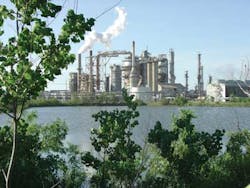P. 6 ~ Continued - Global capacity growth reverses; Asian, Mideast refineries progress
Displaying 6/11
View Article as Single page
The report cautioned, however, that a total of about 1.5 million b/d of the projected refining capacity expansion is to occur in countries where elevated risks might keep plans from being fulfilled: Iraq, Iran, Yemen, and Bahrain.
Of secondary-unit capacities expected to be added in the region, the Deutsche Bank analysis said 40% will be desulfurization and 25% coking. Among the region's major oil producers, total country refining capacity eventually will exceed half of crude oil production capacity in Kuwait, Iran, and Qatar, lowering crude volumes available for export.
In the UAE and Saudi Arabia, refining capacity will remain low relative to growing production capacity. Those five countries—Kuwait, Iran, Qatar, UAE, and Saudi Arabia—account for nearly 25% of global oil production and 85% of Middle Eastern production, said the analysis.
Regional oil demand growth is "far outpacing that of the US and Europe," said the report. Gas oil-diesel accounts for about 30% of Middle Eastern consumption, gasoline about 25%.
Demand for fuel oil, declining elsewhere in the world, remains strong in the Middle East, driven by electric power generation. About 36% of Middle Eastern power generation is fueled by oil, compared with a 7% average worldwide, according to International Energy Agency data cited by the report.
Saudi Arabia is the main reason for the region's heavy use of fuel oil, it said, relying on oil for nearly 60% of its power generation. Of the 20% of Saudi oil demand that applies to power generation, 39% is gas oil, 35% direct-burn crude, and 27% fuel oil.
In December of last year, Saudi Aramco said its planned refinery in the industrial city of Yanbu is slated to start production in 2014, Bloomberg reported. The refinery will process 400,000 b/d of heavy crude to produce diesel and gasoline with byproducts of sulfur and petroleum coke, said the company.
Early this year, Saudi Aramco let a frontend engineering and design (FEED) and project-management contract to KBR for a grassroots refinery in the Jazan area of southern Saudi Arabia. KBR reported crude capacity of the refinery, to be built in conjunction with a marine terminal on the Red Sea, at 400,000 b/d. Aramco earlier had described capacity as 200,000-400,000 b/d.
The refinery will be able to process Arabian crude oils and yield about 75,000 b/d of gasoline, 100,000-160,000 b/d of ultralow-sulfur diesel, and 160,000-220,000 b/d of fuel oil, according to Aramco.
In September, Aramco and France's Total Refinery and Petrochemicals Co. (Satorp) said they expect a new refinery at Jubail in Saudi Arabia to be fully operating in December 2013, according to Reuters.
Aramco and Total are building the $14-billion Jubail plant as part of an effort nearly to double its refining capacity. Although the refinery is designed to process 400,000 b/d, Aramco has committed to supply it with up to 440,000 b/d for 30 years.
Displaying 6/11
View Article as Single page

